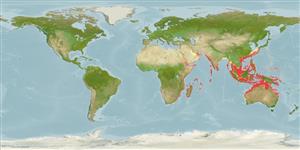Classification / Names
Common names from other countries
Main reference
Size / Weight / Age
Max length : 100.0 cm TL male/unsexed; (Ref. 7050); common length : 60.0 cm TL male/unsexed; (Ref. 3476); max. published weight: 3.5 kg (Ref. 40637)
Length at first maturity
Lm 40.0 range ? - ? cm
Environment
Marine; brackish; reef-associated; oceanodromous (Ref. 51243); depth range 20 - 200 m (Ref. 36128)
Climate / Range
Subtropical, preferred 27°C (Ref. 107945); 32°N - 35°S, 18°E - 157°E
Distribution
Short description
Dorsal
spines
(total): 9 - 10;
Dorsal
soft rays
(total): 13;
Anal
spines: 0;
Anal
soft rays: 13. Brownish or grayish above, whitish below; caudal fin 2-3 horizontal black stripes (Ref. 4315). Head strongly depressed. Preopercular spines 2, lower usually longest. Vomerine teeth in a single transverse band. Dorsal fin I,VII,I, I,I,VII,I or I,VIII, 13. Anteriormost lateral line scale usually with a small spine or ridge. Diagonal scale rows slanting backward above lateral line 83-107. Iris lappet a single elongated lobe. Identified by the distinctive color pattern on the caudal fin: centrally yellow and black stripes on upper and lower margins (Ref. 48635).
IUCN Red List Status (Ref. 115185)
Threat to humans
Harmless
Human uses
Fisheries: commercial; aquaculture: commercial; gamefish: yes
Tools
Special reports
Download XML
Internet sources
Estimates of some properties based on models
Phylogenetic diversity index
PD50 = 0.5000 many relatives (e.g. carps) 0.5 - 2.0 few relatives (e.g. lungfishes)
Trophic Level
3.6 ±0.6 se; Based on diet studies.
Resilience
Medium, minimum population doubling time 1.4 - 4.4 years (tmax=7)
Vulnerability
Moderate vulnerability (37 of 100)
Price category
